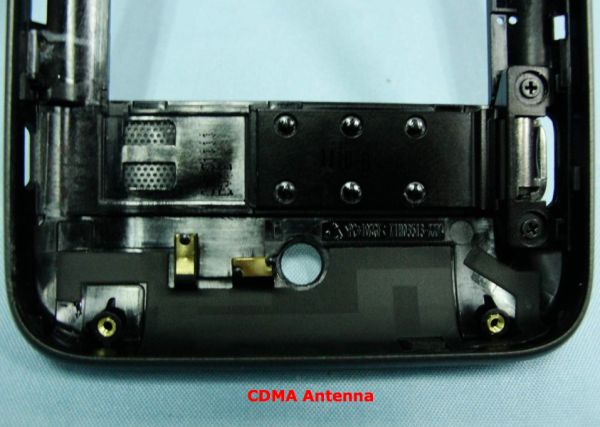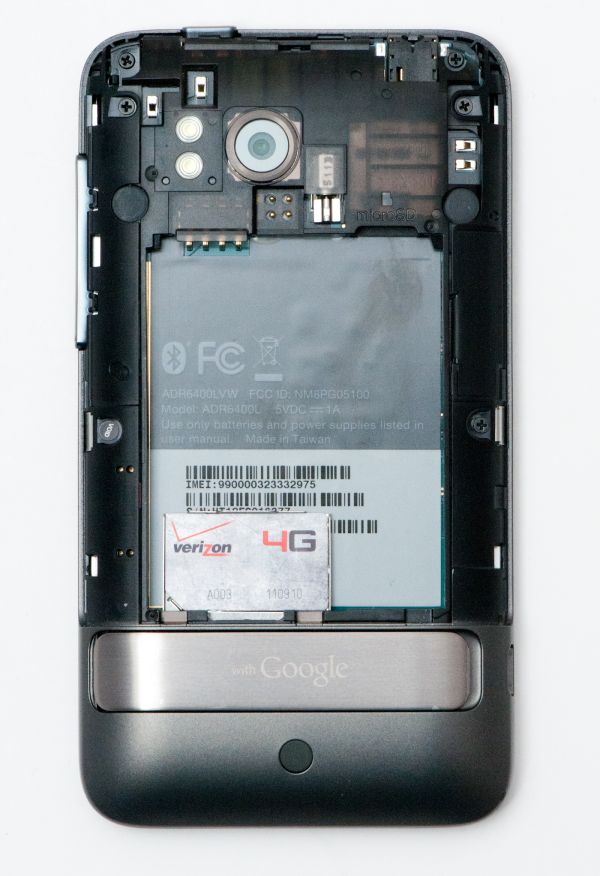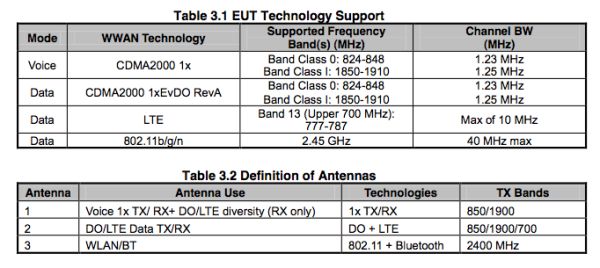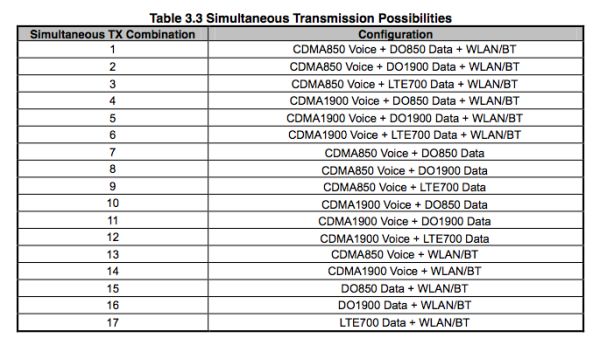HTC Thunderbolt Review: The First Verizon 4G LTE Smartphone
by Brian Klug on April 27, 2011 12:12 AM EST- Posted in
- Smartphones
- HTC
- Verizon
- LTE
- 4G
- Android
- HTC Thunderbolt
- Mobile
- MDM9600
- MSM8655
A Tale of Two Cellular Radios
I suppose now is as good a time as any to delve into the dual transceiver situation on the Thunderbolt. The two transceivers I speak of are the MSM8655’s built in cellular baseband (like all Qualcomm SoCs, you get a modem for free), and the MDM9600 which sits at the heart of every single other Verizon LTE product except the LG VL600 data card, which uses LG’s own L2000 chipset. If you want the short story, the Thunderbolt fully supports simultaneous CDMA2000-1x voice and 3G EVDO or 4G LTE data. The way this is done should already be somewhat obvious - the MSM8655 gives the Thunderbolt a continual free CDMA 1x connection for voice, SMS, and slow data, and the MDM9600 does all the 3G EVDO and 4G LTE data heavy lifting. What this boils down to is real SVDO (Simultaneous Voice Data Optimized) and SVLTE (Simultaneous Voice and Long Term Evolution data).

You can see proof of this in the Thunderbolt’s EPST menus, where there’s a second additional field marked “9k” which clearly is for the MDM9600 (9600, 9k, ahh right).
This situation also starts to become clear when you pry the battery cover off the back of the phone. Getting the battery cover off is incredibly difficult the first time. I swear I almost broke the thing the first time I did it. There are seriously more than ten plastic clips and guides which hold the door securely in position.
The Thunderbolt comes by default with a 1400 mAh, 3.7 VDC (5.18 Whr) battery (the official extended battery is 2750 mAh, 3.7 VDC, 10.18 Whr, as an aside). If you remove the battery, you can access the Thunderbolt’s USIM which slides out long ways first in a metal carrier. This is the first time I’ve seen a SIM door insert this way, but it works.
While we're talking about SIMs, Verizon's is technically both a CSIM and USIM. CDMA credentials are on the SIM (CSIM) as well as the credentials for LTE (USIM). The way the term SIM is abused lately for anything resembling one will likely continue, but if you're going to be pedantic, it's really both. Anyhow, as a result, you can finally swap devices on Verizon without having to call support, give them an ESN, and wait for routing tables to switch everything over. I haven't personally tried it since I don't have two Thunderbolts, but Verizon does advertise this is as a notable feature that finally brings full device portability. This is a huge feature if you intend to swap between devices a lot.
The reason why it’s held on so securely makes sense the second you get it off - there are two antennas back here built into the door. The reason for such a stiff and beefy door is so that no fewer than four independent contacts need to be held in good electrical contact. Count them - two contacts for the top right connector, another for top left, and another for wireless induction charging if you go with the extended battery combo.
Though we never reviewed it formally, the myTouch 4G was the first time I saw HTC start to go down the modular antenna route, with a similarly detachable (internal) antenna board. The Thunderbolt does the same thing here, yet builds it into the battery door. Likewise, the HTC Desire HD does the same thing, as does the upcoming Sensation. It isn’t just Apple that gets creative with antennas now and then, HTC deserves some credit too.
The antenna on the left is for GPS and even bears a marking to that effect on the flex board. The one on the right is for the MDM9600 and thus works for data on LTE and EVDO. There are two holes which punch clean through to the opposite side, clearly to ensure good contact with whatever antenna is built into this battery door.
There are two more antennas on the Thunderbolt, bringing the grand total to four. There’s one in the flex style we’re used to seeing which curves around the back and is for WiFi and BT, and another at the bottom right where we’re used to seeing them for CDMA 1x.
 CDMA 1x Antenna at the bottom, Source: FCC
CDMA 1x Antenna at the bottom, Source: FCC
That’s a bit of a simplification too. If you’ve read anything about LTE or our other piece on it, you should know by now that a large part of the specification is mandatory multiple antenna support. At least on Verizon’s LTE network all devices need to be category 2 or 3, which means they must incorporate MIMO. The HTC Thunderbolt’s UL MIMO configuration is 1x2, meaning it has 1 transmit antenna and 2 receive antennas. The RF chains for both the MSM8655 and MDM9600 basebands are independent, however the two share an Rx antenna at the bottom in the traditional spot. This antenna serves as 1x voice Tx/Rx for the MSM8655, and EVDO/LTE Rx for the MDM9600.
The one at the top is EVDO/LTE Tx/Rx for the MDM9600. You can verify this yourself if you pry the back cover off the phone while in an LTE or EVDO data session - it goes away and you promptly fall back to slow 1x data. Pretty cool though.
I spent a lot of time on the phone with Qualcomm talking about the radios in the Thunderbolt and LTE in general. I ended up learning a ton more about the number of design challenges involved with making SVDO and SVLTE work for the first time and gained an appreciation for even more complexities than I expected.
First off, since this is the first phone (I’m aware of) with dual cellular transceivers that can be active at the same time, Qualcomm and HTC had to work with the FCC to establish proper testing to making sure the Thunderbolt meets FCC SAR (Specific Absorption Rate) requirements. Remember that although the HTC EVO 4G could have conceivably supported simultaneous 4G WiMAX and 1x voice, the feature was disabled and to my knowledge hasn’t ever been enabled. It’s for this reason - until the Thunderbolt no proper procedure for characterizing dual transceiver phones existed. (Update: Apparently the EVO does support simultaneous WiMAX data and 1x voice, thanks everyone!)
Architecting a dual-transciever cellular system that works properly with FCC SAR requirements necessitated some communication and logic between the MDM9600 and MSM8655 basebands. This is noted in addition in the FCC report for the Thunderbolt:
Although the RF circuits are independent for both transmitters, the chipset solution incorporated SVDO/SVLTE implementation does include electrical connections between the voice and data transmitters such that the device can coordinate the transmit power of both transmitters. That said, the transmitters operate independently in the sense that they independently support voice or data connection without interaction between the modems or signaling from the WWAN network.
It’s an edge case, but imagine a situation where you’re at cell’s edge transacting both LTE data and 1x voice. In that circumstance, SAR could theoretically exceed legal limits. To keep this from happening, that communication link between the MDM9600 and MSM8655 lets the Thunderbolt know the power and link budgets for both and allocate accordingly by reducing throughput on the data link. There are a whopping 17 Tx configurations that the Thunderbolt needs to support all while maintaining legal power budgets.
I tested endlessly trying to detect any 4G LTE speed degradation at the cell edge while on a voice call but never could notice anything appreciable.
This wouldn't be a complete review without a measurement to show whether the Thunderbolt is prone to deathgrip. Luckily thanks to the antenna diversity we've outlined, the Thunderbolt really isn't. I've done the due diligence of measuring the handset in our usual positions in both 3G and 4G environments.
| Signal Attenuation Comparison in dB - Lower is Better | ||||||||
| Cupping Tightly | Holding Naturally | Holding in Case | On an Open Palm | |||||
| HTC Thunderbolt - LTE | 5.3 | 2.5 | - | 4.4 | ||||
| HTC Thunderbolt - EVDO | 6.5 | 0.8 | - | 7.2 | ||||
| Verizon iPhone 4 | 16.5 | 15.5 | 9.0 | 7.9 | ||||
| LG Optimus 2X | 13.7 | 9.3 | - | 5.9 | ||||
| Nexus S | 13.3 | 6.1 | - | 4.3 | ||||
| Droid 2 | 11.5 | 5.1 | - | 4.5 | ||||
| BlackBerry Torch | 15.9 | 7.1 | - | 3.7 | ||||
| Dell Streak | 14.0 | 8.7 | - | 4.0 | ||||
| Droid X | 15.0 | 5.1 | - | 4.5 | ||||
| AT&T iPhone 4 | 24.6 | 19.8 | 7.2 | 9.2 | ||||
| iPhone 3GS | 14.3 | 1.9 | 3.2 | 0.2 | ||||
| HTC Nexus One | 17.7 | 10.7 | 7.7 | 6.7 | ||||
The Thunderbolt has noticeably less attenuation when held in a 4G LTE scenario, no doubt thanks in part to the fact that it's fully leveraging MIMO and also on a 700 MHz carrier. I was surprised to see that make any measurable difference. I also saw a considerable amount of variance before the number settled down, which to me definitely indicates some DSP deciding on what link it can reliably hang onto in LTE coverage. In 3G EVDO the picture isn't as complicated, again attenuation is low until you put flesh over both antennas like what happens when it's on an open palm.
















71 Comments
View All Comments
HangFire - Wednesday, April 27, 2011 - link
I credit this to Angry Birds. The bigger the tablet, the better the experience.MilwaukeeMike - Wednesday, April 27, 2011 - link
Well... it comes with a kickstand, clearly they want us to watch movies on them, which means they're not going to get any smaller. Have you ever had one though? It's not that bad. I have a double sized battery on my EVO and the extra width actually makes it easier to take out of my pocket (The ridge by the kickstand makes a little 'handle') and easier to hold sideways.MilwaukeeMike - Wednesday, April 27, 2011 - link
Oh... and a thicker phone means it's more likely in contact with your leg (guys) if in your pocket and increases the chance that you'll feel it when on vibrate.HangFire - Wednesday, April 27, 2011 - link
Brian, great in-depth review.The original Tbolt specs had 8GB of NAND Flash, but mine only reads 4. I've heard a rumor the that half was locked out to help deal with the battery issue, and another rumor that it might be "unlocked" some day. Do you have any info?
Also, some mention should be made of the awful Blockbuster app that comes pre-installed, with permissions to spy on everything, running processes that constantly use data, and cannot be uninstalled short of rooting. HTC and Verizon should be made to understand that such shovelware/crapware is totally unacceptable.
I found the 5MP T-Mobile G2 camera much better indoors/low-light than my Tbolt. Alas, T-Mobile has poor data in my area so I moved over to Verizon and the Tbolt. I think the pointless increase in Megapixels is the cause. I'd like to see better pictures, not better specs.
Brian Klug - Wednesday, April 27, 2011 - link
Interesting, I went with the HTC specifications which list 8 GB, but see what you mean about 4 GB now on this Thunderbolt. Very curious. I don't think the reason could be battery usage since it's nonvolatile, though I've heard lots of discussion about devices with 1 GB+ of RAM using more battery. I'll ask some questions and find out.The funny part about the crapware on the Thunderbolt is that it's actually far less than I see on the Inspire 4G. I haven't seen the Blockbuster app be persistent (though that could be because I haven't launched it), but otherwise yes you're completely right about the preload situation.
-Brian
sooper_anandtech12 - Wednesday, April 27, 2011 - link
Nice to see that the 3.7" 854x480 display on the Droid and Droid 2 still rockin' it as one of THE best displays in the mobile space. As for the push towards qHD displays. To be honest, I would like Motorola and the rest of them to hold off on these qHD displays. They all employ PenTile pixel substructures which effectively means there are less pixels than advertised. Looking at an Atrix display compared to my Droid's display and it's clear the Atrix should have been called Atrocious. The pixelation around widgets and on wallpapers was unacceptable. I haven't seen pixelation like that since AMOLED. Why release qHD PenTile LCDs when Samsung recently admitted PenTile stinks and is going with a normal RGB set up with S-AMOLED+? I'd rather see a nice IPS display like in the LG G2X, running at the antiquated 800x480 than a qHD display running 30% less pixels than the 960x540 that's advertised.mlosee222 - Wednesday, April 27, 2011 - link
Confirmed by threads at xda developers and other sources:http://www.engadget.com/2011/04/27/verizons-lte-ne...
Maybe its just the verizon commercials, but what has me sold is the network. I could honestly care less about the phone compared to the speeds LTE offers. Voice is a secondary consideration to data throughput for me. I would buy the thunderbolt for the network alone.
With that being said, I sincerely hope verizon's LTE isn't as overloaded and useless as T-Mobile's "3G" network is.
hans007 - Wednesday, April 27, 2011 - link
i agree. as someone who just left t-mobile for verizon, their network is terrible now at least for data. their voice isn't really spectacular either.in the bay area, their 3G coverage was really spotty.
and i am also in los angeles a lot and t-mobile has a ton of dead zones. i can't believe they advertise it as 4G as it felt slower than 3G on verizon.
Brian Klug - Wednesday, April 27, 2011 - link
It's a bitter irony really, of course the day after I post everything, eHRPD goes down and takes 4G LTE and 3G EVDO (on eHRPD) with it.If you go into EPST (##778#) and enter MSL (000000), you can change the modem setting under Rev.A to use just HRPD instead of eHRPD. That way, you're anchored through the old 3G data network instead of the common anchor point for EVDO and LTE that appears to be having problems right now.
I've been having sporadic EVDO (eHRPD) connectivity all day with dips to 1x. Unfortunate, but things like this will gradually get better in time.
-Brian
synaesthetic - Thursday, April 28, 2011 - link
Really depends on where you live, and plus you also get what you pay for. T-Mobile is considerably cheaper than Verizon.For slightly less service (assuming I do not buy an LTE device), Verizon charges me $30 more than T-Mobile does. From $65 to $95 for almost exactly the same service (though I lose 50 minutes of anytime minutes on Verizon).
Considering the uncertain future of T-Mobile US, I am considering Verizon as an option, but to me the device--and more specifically, the ROM--is the most important thing as long as my network speeds are decent enough.
For the record, my T-Mobile HSPA+ in downtown Berkeley is excellent, usually 6-7Mbps down and 2-3Mbps up. Absolutely sufficient for my purposes. At home, yeah, in the 'burbs my data speed kind of bites... but I have wifi and much faster wired broadband, why would I bother with using my data plan at home? :D